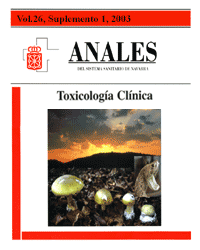Alcohol intoxication
Keywords:
Etanol. Metanol. Intoxicación. Fomepizol. Etilenglicol.Abstract
Alcohol intoxication is the principal drug addiction in many countries of the world. It affects all age groups, both sexes and almost all social groups. Mortality associated with acute alcohol poisoning on its own is exceptional, but it can be an important factor if it coexists with recreational drugs. It is directly responsible for more than half of traffic accidents. Diagnosis is easy by means of anamnesis and clinical examination, and can be confirmed by determining the level of ethanol in the bloodstream. Supportive care is the best therapy in order to protect the patient from secondary complications. Methanol, or alcohol fuel, is used as a solvent, and can also be found as an adulterant of alcoholic drinks. Poisoning by oral means is the most frequent. Oxidized in the liver through dehydrogenase enzyme alcohol, toxicity is due to its metabolites, formaldehyde and formic acid. The clinical picture basically consists of cephalea, nausea, vomiting, hypotension and depression of the central nervous system. The optic nerve is especially sensitive, with total and irreversible blindness as a possible result. Ethylenglicol is used as a solvent and as an antifreeze; toxicity is due to an accumulation of its metabolites. The clinical picture includes symptoms that are held in common with methylalcohol intoxication. Kidney failure due to tubular necrosis and the deposit of oxalate crystals can occur.Downloads
Downloads
Published
How to Cite
Issue
Section
License
La revista Anales del Sistema Sanitario de Navarra es publicada por el Departamento de Salud del Gobierno de Navarra (España), quien conserva los derechos patrimoniales (copyright ) sobre el artículo publicado y favorece y permite la difusión del mismo bajo licencia Creative Commons Reconocimiento-CompartirIgual 4.0 Internacional (CC BY-SA 4.0). Esta licencia permite copiar, usar, difundir, transmitir y exponer públicamente el artículo, siempre que siempre que se cite la autoría y la publicación inicial en Anales del Sistema Sanitario de Navarra, y se distinga la existencia de esta licencia de uso.








